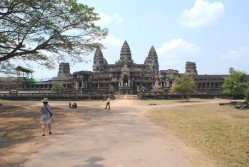
Angkor Wat is without a doubt the most popular tourist attraction in Cambodia. It has become the international symbol of contemporary Cambodia — and this is good in a way, since Cambodia was for many years associated with the genocide wrought by former dictator Pol Pot’s “Khmer Rouge” regime.
Not surprisingly, the crowds you encounter if you visit Angkor Wat these days are more befitting of Disneyland than semi-rural Southeast Asia. As I pushed my way through such unruly mobs when I visited the temple two years ago, I found myself asking a simple question: Is Angkor Wat really worth the effort?
I arranged to arrive at Angkor Wat (which, in case you didn’t know, was the “state temple” and capital city of Suryavarman II, who was emperor of the Khmer Empire that existed in modern Cambodia in the 12th century) on my birthday in 2010, after enjoying some time hanging out on Koh Mak in Thailand. When my friend Gina found out about my trip, she shared the details with her Facebook news feed.
One of her friends decided to rain Haterade on my parade. A few years ago, he wrote, Angkor Wat was nothing short of an archaeological site. Now, it’s like Six Flags Over Cambodia. It’s not even worth visiting — I can’t believe your friend is excited!
At the time, I was furious. How could this person so nonchalantly trash what were, at the time, my grandest travel plans ever?
Angkor Wat and Siem Reap

Even if you hate Angkor Wat, there are plenty of awesome things to see in Siem Reap
I didn’t know why he’d been such a dick, but I also didn’t give a rat’s ass. I arrived to Siem Reap, the city located nearest Angkor Wat, relatively late in the afternoon on my birthday. So late, in fact, that I got to the Angkor Wat admission gate literally minutes before it closed for the day.
I was shocked to find what appeared to be thousands of tourists stumbling around the Angkor Wat grounds. Actually, “shocked” isn’t the right word — the sun was about to set, after all, making for incredible photo opportunities most people would be crazy to miss.
To be sure, the crowds I encountered that day and on the two separate occasions I visited Angkor Wat after that weren’t enough to take away from the experience of being in the massive temple complex.
That’s another item to note: Angkor Wat is massive. Although you’re unlikely to get a shot of the main Angkor Wat façade without at least a few hundred tourists in the foreground, the temple complex extends for no less than a kilometer, and the further into it you walk, the less crowded it becomes. So there’s that.
And let’s assume you are disappointed when you arrive? No biggie. Siem Reap is cool as shit.
Cost of Visiting Angkor Wat

Come on, do you really think this is “overrated”?
I mentioned in the previous section that I visited Angkor Wat several times over the course of my Cambodia trip. That’s because I purchased a multi-day pass at the entry gate.
When I traveled to Cambodia in February 2010, a three-day Angkor Wat pass — in other words, unlimited visits over the course of three consecutive days — cost $40, payable in U.S. dollars. I would imagine the cost of the pass has increased since then. By contrast, a one-day ticket cost $20. So, in effect, I saved $20 by purchasing the three-day pass.
What does this mean for you? Even if the price has increased (and as I said, I’d almost bet money that is has) you are probably better off purchasing the three-day pass, rather than a one-day ticket. The worst-case scenario is that you visit only once and you’re out the premium you paid. But again, I doubt this will be the case — you will definitely be able to find enjoyment in the outer reaches of the temple complex.
And how exactly do you get to Agnkor Wat? Simply take a tuk-tuk or taxi from Siem Reap’s center, located approximately four kilometers away. You shouldn’t expect to pay more than $1 each way, although your driver will probably quote you more than this initially.
Angkor Wat Alternatives

Ta Prohm speaks for itself RE: why you should visit
The great thing about the Siem Reap area is that it’s far from a one-man show: Angkor Wat is but one of many incredible ancient temples in the area, even if all of them don’t have the same incredible history as Angkor Wat.
My personal favorite of these is Ta Prohm, a smaller temple complex that was built slightly later than Angkor Wat, originally serving as a monastery for Emperor Jayavarman VII. Ta Prohm, which is notable for the fact that trees quite literally grow out it, has gained modern notoriety after being featured prominently in the “Tomb Raider” film franchise.
Another popular temple located nearby Angkor Wat is Angkor Thom which, like Ta Prohm, was built by Jayavarman VII.
The bottom line is this: Even if you despise Angkor Wat (highly unlikely), there are more than enough amazing attractions in the Siem Reap area to keep you delighted and entertained.

Robert Schrader is a travel writer and photographer who’s been roaming the world independently since 2005, writing for publications such as “CNNGo” and “Shanghaiist” along the way. His blog, Leave Your Daily Hell, provides a mix of travel advice, destination guides and personal essays covering the more esoteric aspects of life as a traveler.








